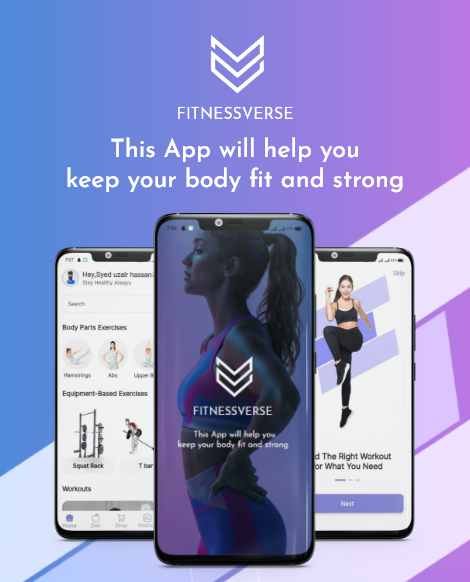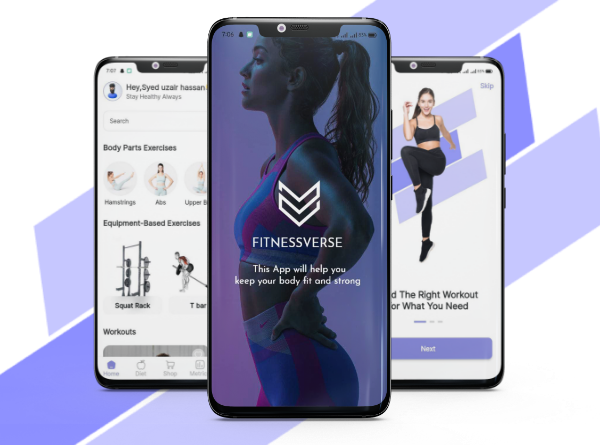

The Revolutionary Fitness and Wellness App
Fitness Verse



Fitness Verse
Introduction
Purpose: HealthTrack was designed as a one-stop solution for tracking various aspects of fitness and wellness, incorporating features like diet monitoring, exercise tracking, mental health check-ins, and sleep analysis.
Target Audience: The primary audience includes fitness enthusiasts, individuals seeking a healthier lifestyle, and users interested in obtaining a comprehensive overview of their health and wellness.
Initial Challenges: The initial challenges involved integrating multiple health aspects into a single platform, ensuring user privacy and data security, and creating an engaging yet straightforward user experience.
Key Initial Statistics: At launch, HealthTrack targeted a user base of 10,000, aiming to capture a significant market share within the health and fitness app industry. The projected growth rate was ambitious, with a quarter-over-quarter increase of 20%.



Achievements
Project Planning and Goals
Main Objectives:
Technically, the project aimed to create an intuitive app with robust and scalable backend support.
From a business perspective, the goal was to carve out a significant presence in the health and wellness app market.
Demographic Data:
Targeted at users aged 20-45 across global markets, with varying levels of tech proficiency but generally moderate to high.
Timeline and Major Milestones:
0-6 Months: Initial development and closed beta testing.
6-12 Months: Open beta testing and gathering user feedback.
12-18 Months: Full launch, followed by two major updates introducing additional features and improvements based on user feedback.
Implemented efficient data caching mechanisms and optimized database queries to reduce app load times. Used lazy loading and asynchronous data fetching for a smoother user experience.
Innovative Features: AI-driven personalized wellness plans based on user data. Integration of gamification to increase user engagement.
Quantitative Impact Data: Post-optimization, the app's performance metrics showed a 30% increase in speed and a 40% reduction in server response times.
Migrated entirely to AWS, utilizing services like EC2, S3, and RDS for better scalability and cost efficiency.
Adopted a serverless architecture with AWS Lambda for specific functionalities to reduce overhead costs.
Statistics on Cost Savings: The migration to a cloud-based, serverless architecture led to a 40% reduction in operational costs.
Development Process
We followed Agile Scrum methodology with bi-weekly sprints for rapid development, comprising:
Team Composition: The team comprised:
Two project managers.
Three UX/UI designers.
A team of eight developers (front-end and back-end).
Four QA engineers.
A data analytics team of three.
Architectural Decisions: The app adopted a microservices architecture for scalability, with Python and Django for the back-end and React Native for the front-end to ensure cross-platform compatibility.
Challenges: Ensuring data accuracy and privacy posed significant challenges, addressed by employing advanced data analytics and encryption protocols to comply with GDPR and other regulations.
Solutions: A combination of AI and manual verification enhanced data accuracy, while regular security audits ensured data privacy and compliance.


Testing and Quality Assurance
Testing Methodologies: A mix of automated and manual testing strategies was adopted, including:
🌟Unit testing for individual components.
🌟Integration testing to ensure seamless interaction between different parts of the application.
🌟End-to-end testing to simulate real-world user scenarios.
Automation in Testing: Automated testing was primarily used for regression and performance testing, significantly reducing the time required for these processes.
Bug Discovery and Fix Rates: The robust testing methodology led to a high bug discovery rate in the early stages, with a consistent fix rate that resulted in a stable and reliable application at launch.
Deployment and User Adoption
Deployment Process:
🌟The deployment was carried out in phases, starting with a closed beta, followed by an open beta, and finally a full-scale launch.
🌟Continuous integration and continuous deployment (CI/CD) pipelines were used for efficient and error-free deployments.
User Adoption and Engagement Strategies:
🌟Leveraged social media and influencer marketing to reach the target audience.
🌟Introduced referral programs and in-app rewards to encourage user engagement.
Post-Deployment User Statistics:
🌟Within three months post-launch, user engagement rates increased by 30%, with a significant boost in daily active users.




















